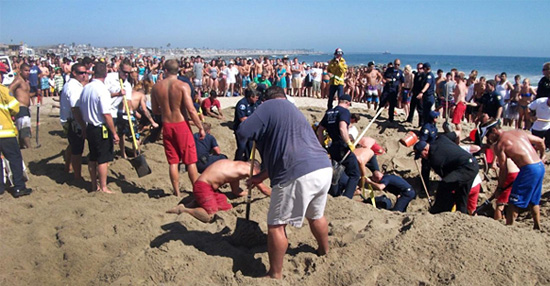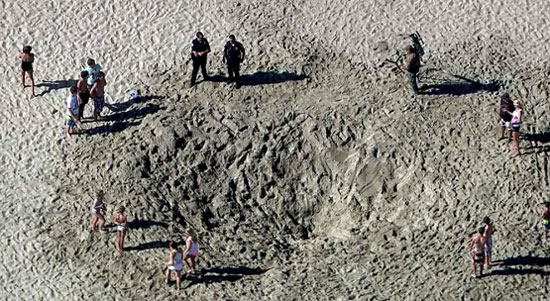Stopping a danger in the sand
April 4, 2012

Rescuers work feverishly to uncover a teen in Newport Beach who was buried for 30 minutes but survived.
The county’s new beach ordinance may have launched more than its share of wisecracks about allegedly outlaw Frisbees, but lifeguards say that at least one of the less-discussed changes could save lives—and that’s no joke.
The new law, which won final approval from the Board of Supervisors on Tuesday, bans the digging of holes deeper than 18 inches to avert dangers not widely known to beachgoers, said Los Angeles County Lifeguard Section Chief Mickey Gallagher.
“In my 40-year career, people have been badly injured and even killed as a result of sand tunneling,” he said. “This is about a safety hazard. It isn’t about little kids with plastic shovels digging a little hole in the sand.”
Last August, for instance, a teenager was buried alive for more than 30 minutes in Newport Beach. The then-17-year-old boy was building a tunnel when the sand collapsed around him. He survived, several feet below ground, only because he had managed to wiggle his head a little as the sand poured in around him, creating a slight air pocket that kept him alive long enough for emergency crews and bystanders to get to him.
Two months before that, in June 2011, a Northern California teenager on a beach outing with a church group was permanently disabled after being buried for more than 10 minutes when a sand tunnel collapsed on him.
In the same week, according to Los Angeles County lifeguard records, a 10-year-old boy in Manhattan Beach was rescued from a similar situation—only the top of the boy’s head was showing when the lifeguard found him. He’d been lying on his back in a hole, tunneling laterally, and had ignored a prior warning to stop digging because it was dangerous.
Nine months earlier, on Labor Day weekend, a 3-year-old toddler was taken by air ambulance from Zuma Beach to Harbor-UCLA Medical Center after she crawled into a sand hole that had collapsed on her, county lifeguard records show.
And two months before that, on July 25, 2010, an 11-year-old boy burrowing in Manhattan Beach was buried for five minutes as more than a dozen beachgoers, emergency workers and lifeguards tried frantically to extricate him. Lifeguards later said that the only reason they even located him was that his cousin had run, screaming, for help and one of his rescuers had glimpsed a patch of his blue swim trunks as they dug blindly under the sand’s surface. By the time he was pulled free, his lips were blue and he had stopped breathing; he vomited sand after a physician who happened to be at the scene administered mouth-to-mouth resuscitation.
“Sand is really unstable, even when it’s hard-packed,” said Gallagher. “Every year, someone will try to dig a deep hole, or tunnel in from a steep berm after a high tide and get into trouble. Some people actually come down to the beach with big shovels, like you use in construction.
“People think they can make a tunnel or a cave, and to the untrained eye, the sand may seem fine because it’s wet. But without support, those tunnels will collapse, and sand is extremely heavy. And once someone is buried, it’s extremely hard to find them. And there’s no oxygen down there.”
The revisions to the beach ordinance make a number of other clarifications to the existing rules for recreation at the beach. Among other things, they make clear for the first time that Frisbees and footballs are allowed on the beach, albeit with certain restrictions. (Basically, you can do it anytime except when it endangers someone or a lifeguard deems it unsafe.)
Inaccurate press reports initially drew criticism of the changes, including the ban on digging, which was derided as meddlesome fun-killing. But Beaches & Harbors Director Santos Kreimann says lifeguards requested the digging restrictions so they could have legal backup in preventing a problem they’ve informally been guarding against for generations.
Beyond dangers to the diggers, Kreimann said, holes in the sand also create a hazard for emergency workers, who are jolted by them when they transport people with neck and back injuries.
“The bottom line is: Have a good time and play in the sand if you want to,” Kreimann said. “But don’t dig more than knee-deep, and if you make a hole, fill it back up.”

All that's left: the hole in Newport Beach where sand swallowed a 17-year-old boy. Photo/Los Angeles Times
Posted 4/3/12












 405 bridge work causes a stink
405 bridge work causes a stink
